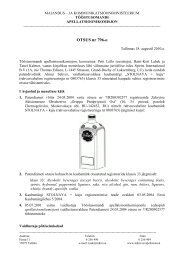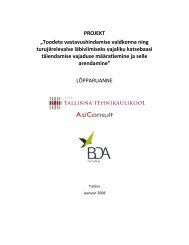Feasibility study for an Estonian Materials Technology Programme
Feasibility study for an Estonian Materials Technology Programme
Feasibility study for an Estonian Materials Technology Programme
You also want an ePaper? Increase the reach of your titles
YUMPU automatically turns print PDFs into web optimized ePapers that Google loves.
44<br />
<strong>Feasibility</strong> <strong>study</strong> <strong>for</strong> <strong>an</strong> Estoni<strong>an</strong> <strong>Materials</strong> <strong>Technology</strong> <strong>Programme</strong><br />
2. <strong>Materials</strong> technology in Estonia<br />
Summary <strong>an</strong>d key factors <strong>for</strong> future<br />
The key target <strong>for</strong> NordBioChem at the moment is to find <strong>an</strong> investor, which would be willing to establish <strong>an</strong><br />
industrial production facility based on NordBioChem’s technology. This would require a relatively huge investment<br />
<strong>an</strong>d it is highly unlikely that Estoni<strong>an</strong> comp<strong>an</strong>ies or investors would be interested in such a project.<br />
There<strong>for</strong>e, the comp<strong>an</strong>y is negotiating with various international players <strong>for</strong> the possibilities to either license or<br />
buy the technology to establish production.<br />
As a conclusion:<br />
NordBioChem has developed economically very effective <strong>an</strong>d very sustainable breakthrough technology<br />
<strong>for</strong> bulk-size basic chemistry allowing <strong>for</strong> the replacement of oil with renewable non-food sources.<br />
The Estoni<strong>an</strong> based NordBioChem has done most of its technological development, including creating 10<br />
patents, outside of Estonia<br />
The still in private Estoni<strong>an</strong> ownership comp<strong>an</strong>y has benefitted from Estoni<strong>an</strong> public development support<br />
programs, but that wasn’t sufficient <strong>for</strong> commercial implementation of these technologies<br />
Contact <strong>an</strong>d more in<strong>for</strong>mation: Vambola Kolbakov, http://www.nordbiochem.eu<br />
2.4.5 Construction materials<br />
Industry overview<br />
There is a lot of diversity in the Estoni<strong>an</strong> construction materials industry. The sector consists of comp<strong>an</strong>ies<br />
producing basic materials such as cement as well as glass <strong>an</strong>d prefabricated building components. Some of<br />
the largest construction materials providers in Estonia include Krimelte (Seal<strong>an</strong>ts <strong>an</strong>d insulating foams), Ruukki<br />
Products (steel), Henkel Makroflex (foams <strong>an</strong>d seal<strong>an</strong>ts), ES Sadolin (paints <strong>an</strong>d alkyds) <strong>an</strong>d Kunda Nordic<br />
Tsement (cement). The largest areas of construction materials produced in Estonia are there<strong>for</strong>e mineral based<br />
products (cement, concrete <strong>an</strong>d mortar, lime <strong>an</strong>d clinker), construction chemicals (paints, alkyds, seal<strong>an</strong>ts <strong>an</strong>d<br />
foams) <strong>an</strong>d prefabricated structural components <strong>for</strong> civil engineering (e.g. windows).<br />
In total, the sales of the member comp<strong>an</strong>ies of the Association of Construction Material Producers of Estonia<br />
were 687 million EUR in 2007 be<strong>for</strong>e the economic downturn <strong>an</strong>d the industry employed about 5000 people<br />
at the time. Construction materials industry is mostly rather local due to the relatively low price of raw materials<br />
<strong>an</strong>d massive products that are expensive to ship to dist<strong>an</strong>t locations. About 27% of construction materials<br />
produced in Estonia were exported mainly to neighbouring countries such as Latvia, Lithu<strong>an</strong>ia, Finl<strong>an</strong>d <strong>an</strong>d<br />
Russia. Krimelte is among the largest exporters with approximately 95% of production exported, mainly to<br />
Russia.<br />
R&D <strong>an</strong>d education: national resources <strong>an</strong>d international comparison<br />
Most of the producers use domestic raw materials <strong>an</strong>d the pl<strong>an</strong>ts are usually situated close to the natural<br />
resources, which include s<strong>an</strong>d, clay, limestone <strong>an</strong>d dolomite. Utilisation of oil shale fly ash <strong>an</strong>d other waste<br />
is <strong>an</strong>other source <strong>for</strong> construction materials studied in Tallinn University of <strong>Technology</strong> but has not resulted<br />
in high volume industrial utilisation yet. High level research <strong>an</strong>d education related to civil engineering <strong>an</strong>d<br />
construction materials is mostly done at Tallinn University of <strong>Technology</strong> <strong>an</strong>d partly at Estoni<strong>an</strong> Agricultural<br />
University. Vocational education is given at Tallinn Technical School. 38 In addition to abovementioned fields,<br />
steel is <strong>an</strong>other globally import<strong>an</strong>t construction material but Estonia mostly lacks the basic metals production<br />
sector <strong>an</strong>d there<strong>for</strong>e, constructional steelwork is not further discussed in the <strong>study</strong>.<br />
The main adv<strong>an</strong>tages of the Estoni<strong>an</strong> construction materials sector are the access to inexpensive natural<br />
resources locally <strong>an</strong>d low production costs due to relatively low salaries. However, the comp<strong>an</strong>ies in Estonia are<br />
quite small <strong>an</strong>d have neither high ability nor drive to adopt adv<strong>an</strong>ced technologies.<br />
38 http://www.investinestonia.com/en/key-sectors/construction-materials





